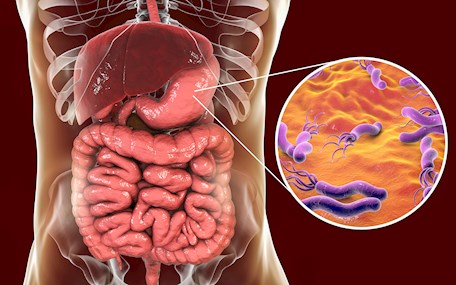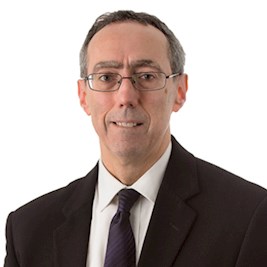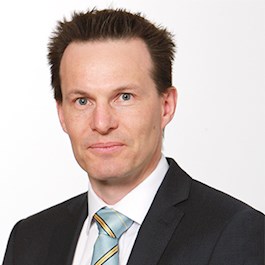Urea Breath Testing in General Practice
Written by Dr Wessel Jenner
Diagnosing H. pylori
Helicobacter Pylori (H. pylori) is a spiral shaped gram-negative bacteria that colonises the mucous layer of the stomach.
H. pylori causes a chronic inflammatory reaction in the mucous layer and can lead to an increased risk of developing peptic ulcers, duodenal ulcers or some cancers of the stomach.
Infection appears to be acquired during childhood and persists lifelong unless treated. It is postulated that one can become infected by contact with saliva, vomit or stools of an infected person. It’s unusual to catch the infection as an adult.
The urea breath test is an accurate, safe and quick way to diagnose H. pylori.
14C-Urea Breath Testing - Clinical Recommendations
- People with duodenal or stomach ulcers.
- People with non-ulcer dyspepsia.
- Monitoring the success of eradication of H. pylori infection.
- In some cases, family members of infected people.
How does the test work?
The H. pylori bacteria is very effective in breaking down urea into CO2 and ammonia to create an environment in the stomach for it to survive. During the urea breath test, the patient is given a capsule that contains urea labelled with 14C. The H. pylori, if present, will break down the urea quickly and release the 14C in the form of 14CO2 that is exhaled. The 14CO2 is collected in a balloon and sent to a laboratory where the 14CO2 content is measured.
If the bacteria is not present, the labelled urea will not be broken down and the breath will not contain 14CO2.
How safe is this test?
14C is a rare, naturally occurring radioactive form of carbon, as opposed to the more common occurring 12C. The radiation exposure during the test is far less than that of a standard X-ray. Studies have not been done to determine safety in pregnancy, or for breast feeding mothers and children so use in these groups is not recommended unless there are special circumstances.
As an alternative in these cases a stool antigen test can be ordered.

Helicobacter pylori bacteria colonising the stomach.
Patient preparation
To avoid inaccurate results, the following precautions should be taken:
- Patient should fast for at least 4 hours before the test (including water).
- The following medication should be discontinued to prevent false negative results:
| Antibiotics and bismuth containing products | 4 weeks before test |
| Cytoprotectives, e.g. Sucralfate | 2 weeks before test |
| Proton pump inhibitors | 1 week before test |
| H2-antagonists and antacids | During fasting and during test |
Cost:
Bulk billed subject to Medicare criteria.
About the author - Dr Wessel Jenner
Qualifications: BSc, MBChB, FRCPA
Lab: Bella Vista
Areas Of Interest: Chemical Pathology, Endocrinology and Proteins
Specialities: Biochemistry, Chemical Pathology
Phone: 1300 134 111
Email: Wessel.Jenner@clinicallabs.com.au
Dr Jenner completed his studies in chemistry and biochemistry in 1992 followed by a Bachelor’s degree in Medicine and Surgery (MBChB) from the Faculty of Health Sciences, University of Pretoria, South Africa in 1997. Following three years of clinical practice, he commenced training in Chemical Pathology in 2001 and obtained the Fellowship from the Colleges of Medicine of South Africa in 2004 and a Master’s degree in Chemical Pathology from the University of Pretoria in 2005. Dr Jenner obtained his Fellowship from the Royal College of Pathologists of Australasia in 2013 and joined Australian Clinical Labs (formerly Healthscope Pathology) in early 2014.
Local pathologists near you

Dr David Deam
Qualifications: MBBS, MAACB, FRCPA
Lab: Clayton
Areas Of Interest: Endocrine Function Testing, Protein Abnormalities, Laboratory Automation
Speciality: Chemical Pathology
Phone: (03) 9538 6777
Email: David.Deam@clinicallabs.com.au
Dr Deam graduated with Honours in Medicine from Monash University in 1978 and obtained his FRCPA in 1985 following postgraduate training in Biochemistry at the Royal Melbourne Hospital. He joined Gribbles Pathology (now Australian Clinical Labs) in 1998. Dr Deam has played an active role in teaching scientific, nursing and medical staff at both undergraduate and postgraduate levels and has been an examiner for the Australasian Association of Clinical Biochemists as well as the Royal College of Pathologists of Australasia.

Dr Damon Bell
Qualifications: MB ChB, PhD, FRACP, FRCPA, FFSc
Lab: Osborne Park
Areas Of Interest: General endocrinology, diabetes, insulin resistance, metabolism, lipid disorders, hypertension and cardiovascular disease Speciality: Chemical Pathology
Phone: 1300 367 674
Email: Damon.Bell@clinicallabs.com.au
Dr Damon Bell received his undergraduate medical education in New Zealand graduating from the University of Otago. He completed his physician training in Endocrinology (FRCPA) and subsequently chemical pathology training (FRCPA) at Wellington Hospital. Dr Bell is also a sessional Chemical Pathologist for PathWest and Physician in the School of Medicine & Pharmacology, UWA based at Royal Perth Hospital. His current research interests relate to screening strategies for familial hypercholesterolaemia (FH) which complements his clinical practice in the Lipid Disorders Clinic.

Dr Travis Brown
Qualifications: B. COM/B. COMP, B. SCI (MED SCI), MBBS, FRCPA
Lab: Adelaide Airport
Areas Of Interest: Information Technology and Pathology informatics
Speciality: General Pathology
Phone: (08) 8205 5604
Email: Travis.Brown@clinicallabs.com.au
Dr Travis Brown obtained his MBBS from the Australian National University (ANU) in Canberra. After completing two years as a junior doctor at St Vincent Hospital in Melbourne, he undertook Anatomical Pathology training at Ballarat Base Hospital and the Royal Melbourne Hospital before transferring to General Pathology Specialty training with Healthscope Pathology (now Australian Clinical Labs) in Clayton,
Melbourne. Dr Brown completed General Pathology Specialty training in November 2016 and now works at Australian Clinical Labs in Wayville, Adelaide.



